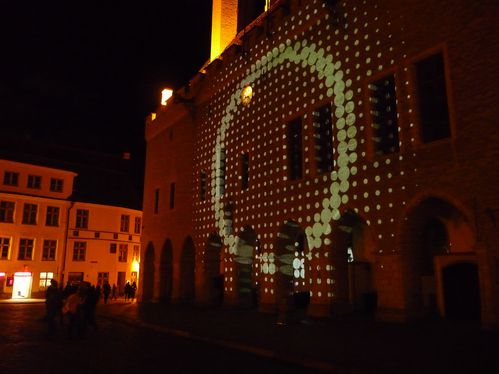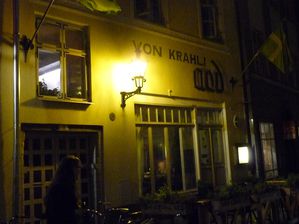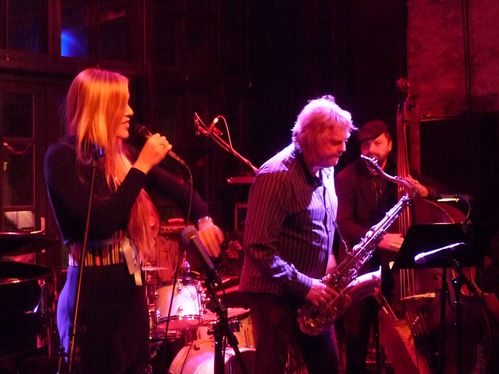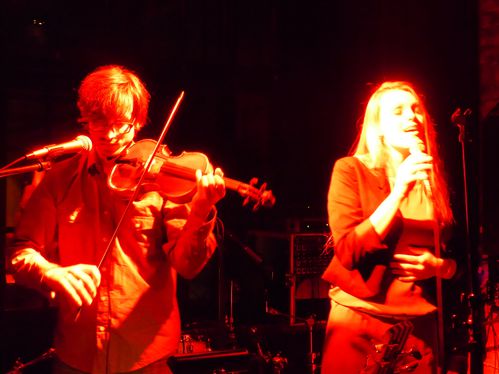Jazz session
Samedi soir jazzi / Tallinn by night

Mon bar préféré à Tallinn pour des samedis soirs colorés, c'est le Von Krahli Theater. C'est un bar théâtre vraiment chouette, où je découvre toujours de nouveaux groupes de musique et de théâtre. On y danse, on rencontre tous type de personnes, on y mange et le vin rouge (un peu chaud) n'est qu'à deux euros..!

Petite introduction sur le jazz à Tallinn, intimement lié avec l'histoire de l'Estonie / A little introduction about the jazz in Tallinn, linked with the History of Estonia I think:
The birth of Estonian Jazz can be dated differently, depending on what we take as the starting point. It could be the year 1918 - incidentally, also the birth of the Republic of Estonia -, when a group of schoolboys, led by drummer Kurt Strobel, started rehearsing and performing "light music" in Tallinn.

(Tanel Ruben Quintet)
During the following 15 years - that is until 2nd WW - Estonian Jazz developed rapidly.
And while at first the music was almost entirely American, learned from mail-order scores or transcribed from records, short-wave radio programs and "sound films", the first Estonian musicians started composing original music for jazz band.
By the end of the 1930's, the Estonian Broadcasting Company had started weekly Saturday night transmissions of "modern dance music" (including jazz). For a tiny European country which, at time, was still largely agricultural, we could say the jazz scene in Estonia was booming.
All that changed, however, with the 2nd WW.
In 1940, Estonia was annexed by the Soviet union, and when germany attacked it in 1941, many young jazzmen were forced to join the occupying Soviet Army. Soon, it retreated and Estonia was occupied by nazi Germany- meaning constant curfews and official banning of jazz as "Entarete Musik", "degenerate music".

(Ingrid Lukas)
After the Soviets had re-occupied Estonia in 1944 and Germany had capituled in 1945, some relatively brighter years followed for Estonian jazz. Musicians returning from the Soviets army (even during the war, the Estonian Riffle Corps had formed a jazz orchestra of its soldiers!) were allowed to entertain the people who had suffered horrible losses from the war.
In 1949 there were mass deportations of innocent people from Estonia to Siberia, and following years marked the darkest times of Stalin's terror. Every artist had to fear their work might be labelled "Anti-Soviets" and even playing the saxophone was too risky. "Today you play jazz, tomorrow you'll betray your country" was an infamous slogan from these days.
(The State of Zoé)
After Stalin's death in 1953, the situation starts to get better slowly. in the 1960's, a new generation of jazz-savvy composers emerged, their compositions were allowed to be played and recorded.
And the brightest moments for jazz in Soviet Estonia of the 60's were the Tallinn Jazz Festivals in 1966 and especially, 1967. It was a massive cultural explosion that go out of the hands of the Party officials, so the Tallinn Jazz Festival planned for 1968 was banned.
During the following decades, however, Soviet Estonia was relatively safe place to play jazz. Some of Estonia's best jazzmen (Tiit Paulus on guitar, Lembit Saarsalu on saxophone…) were among the best players of their respective instruments in the Soviet Union.
In 2000's ,jazz in every possible style has been played in Estonia.
